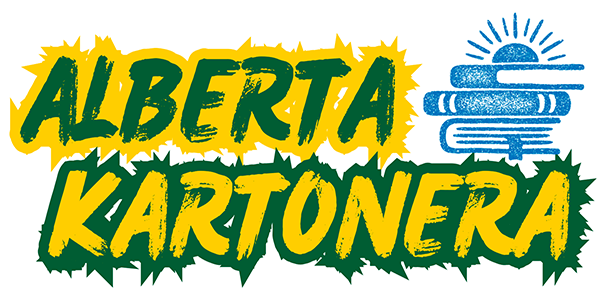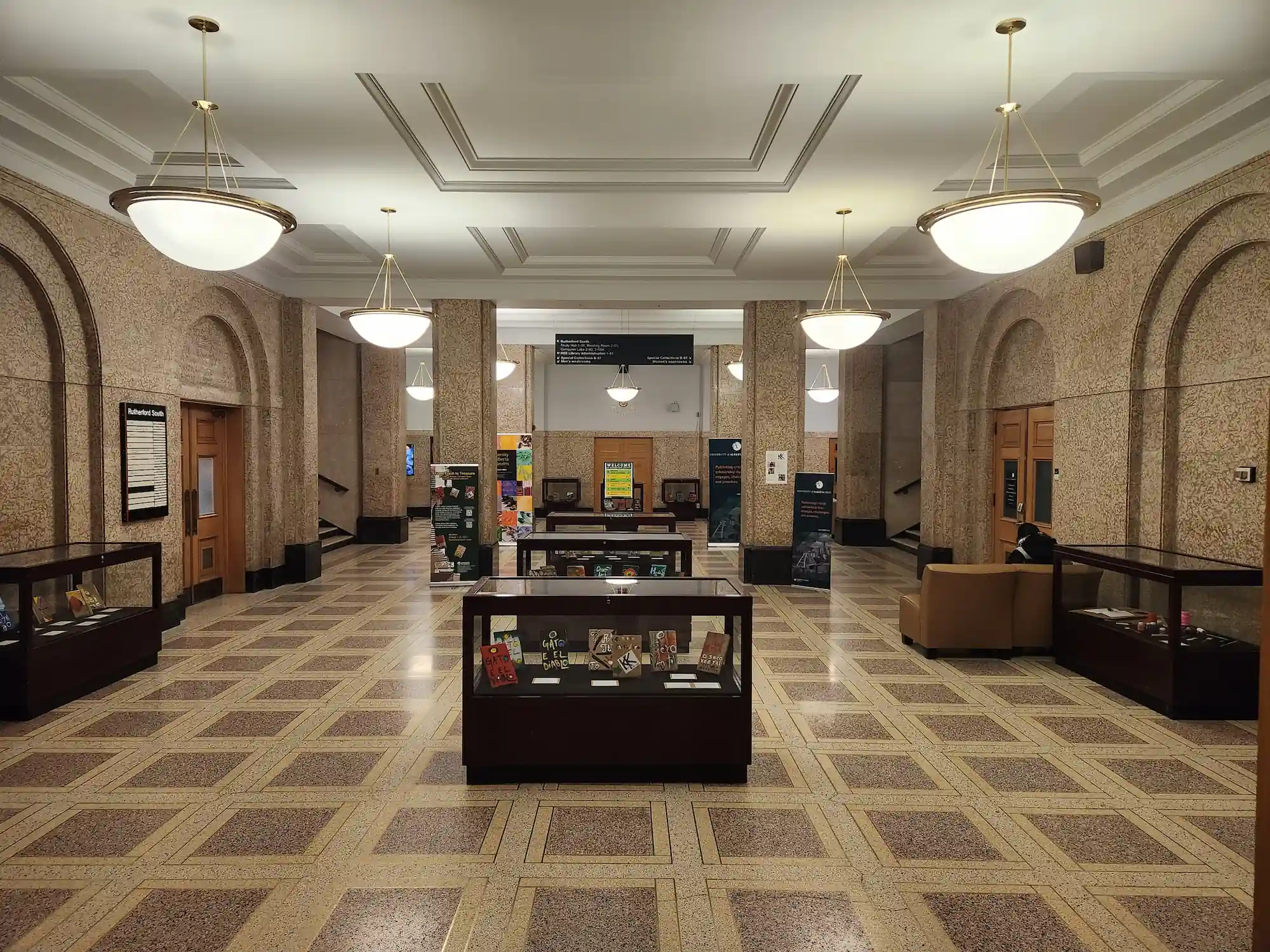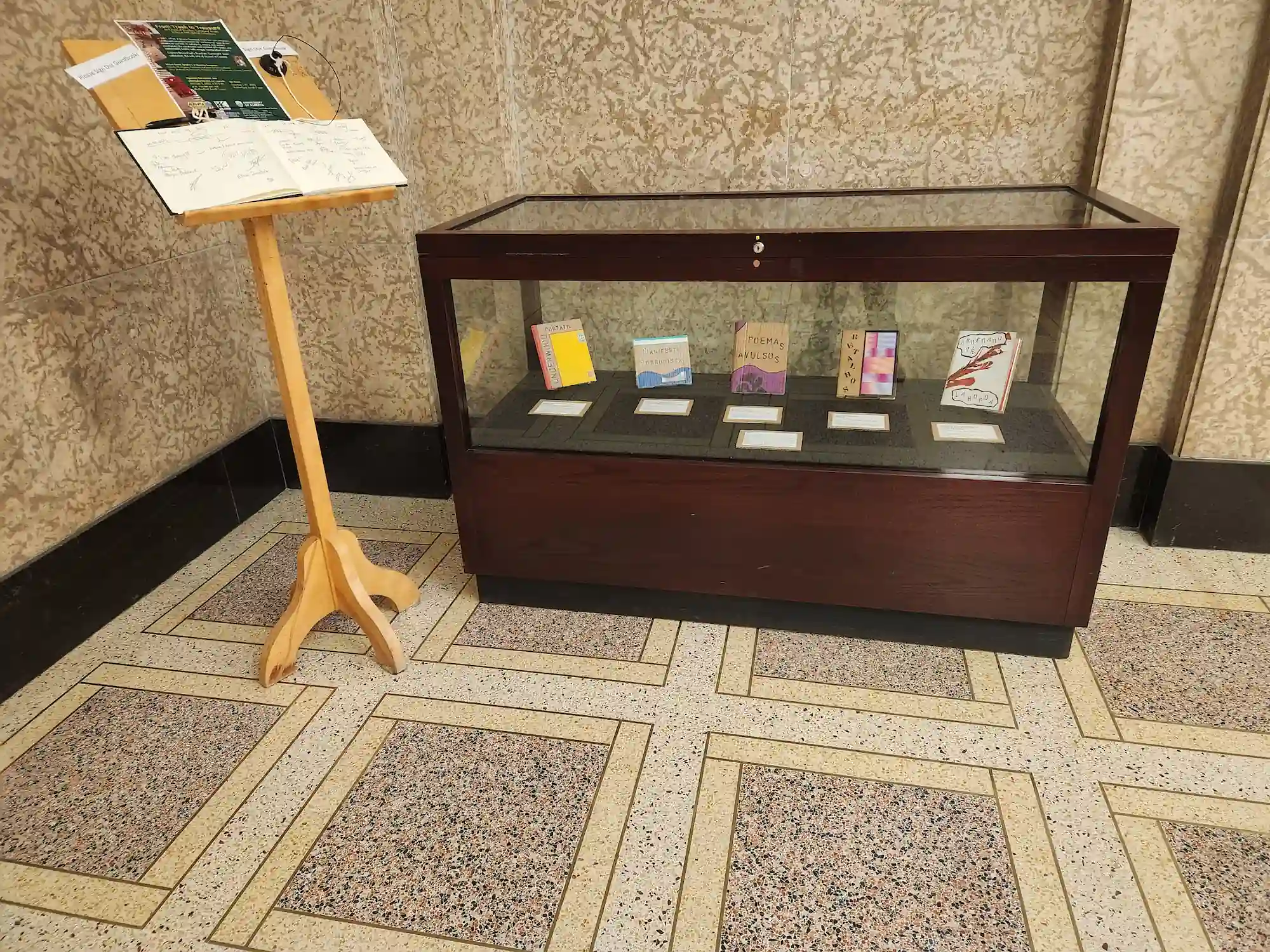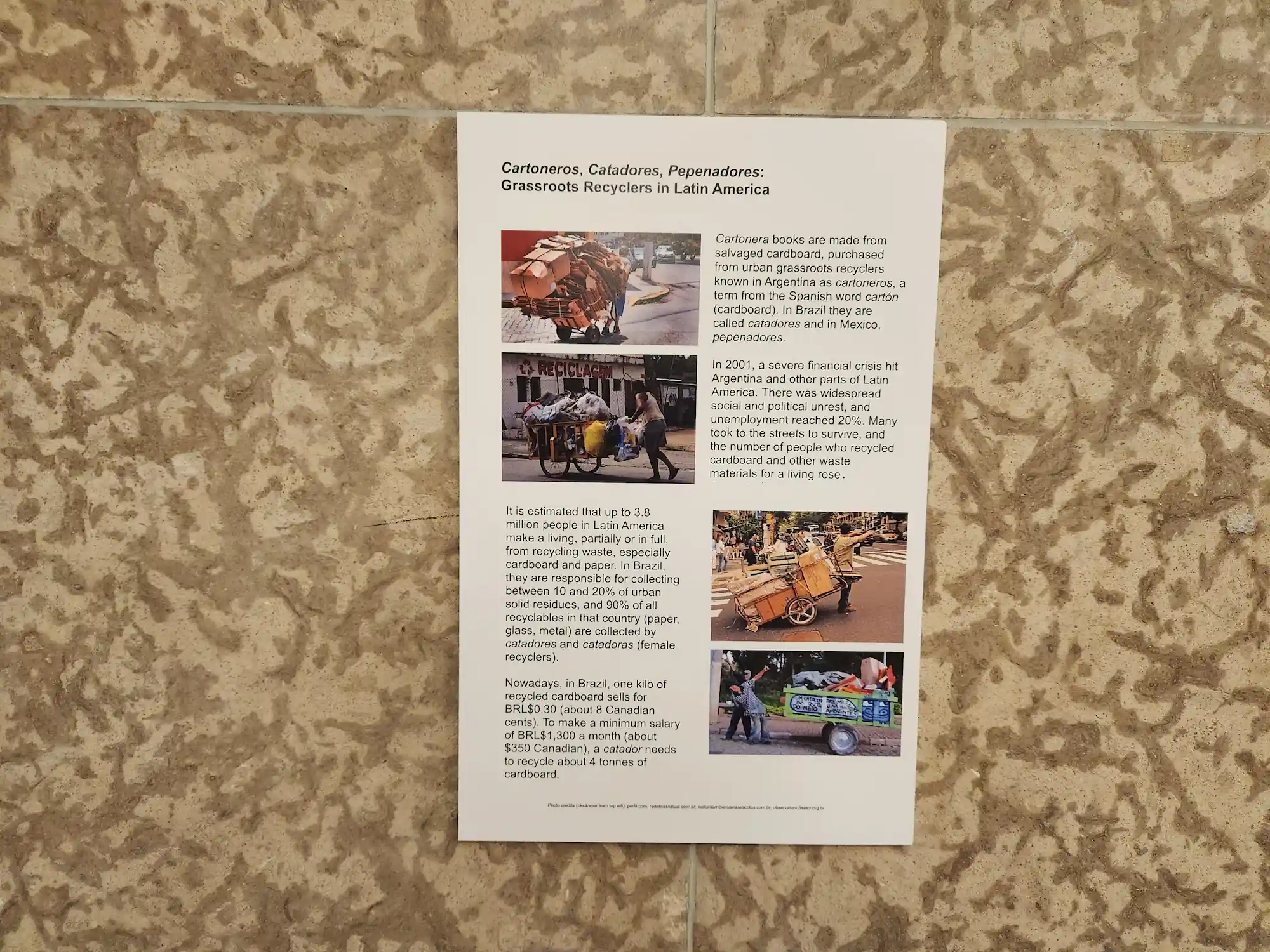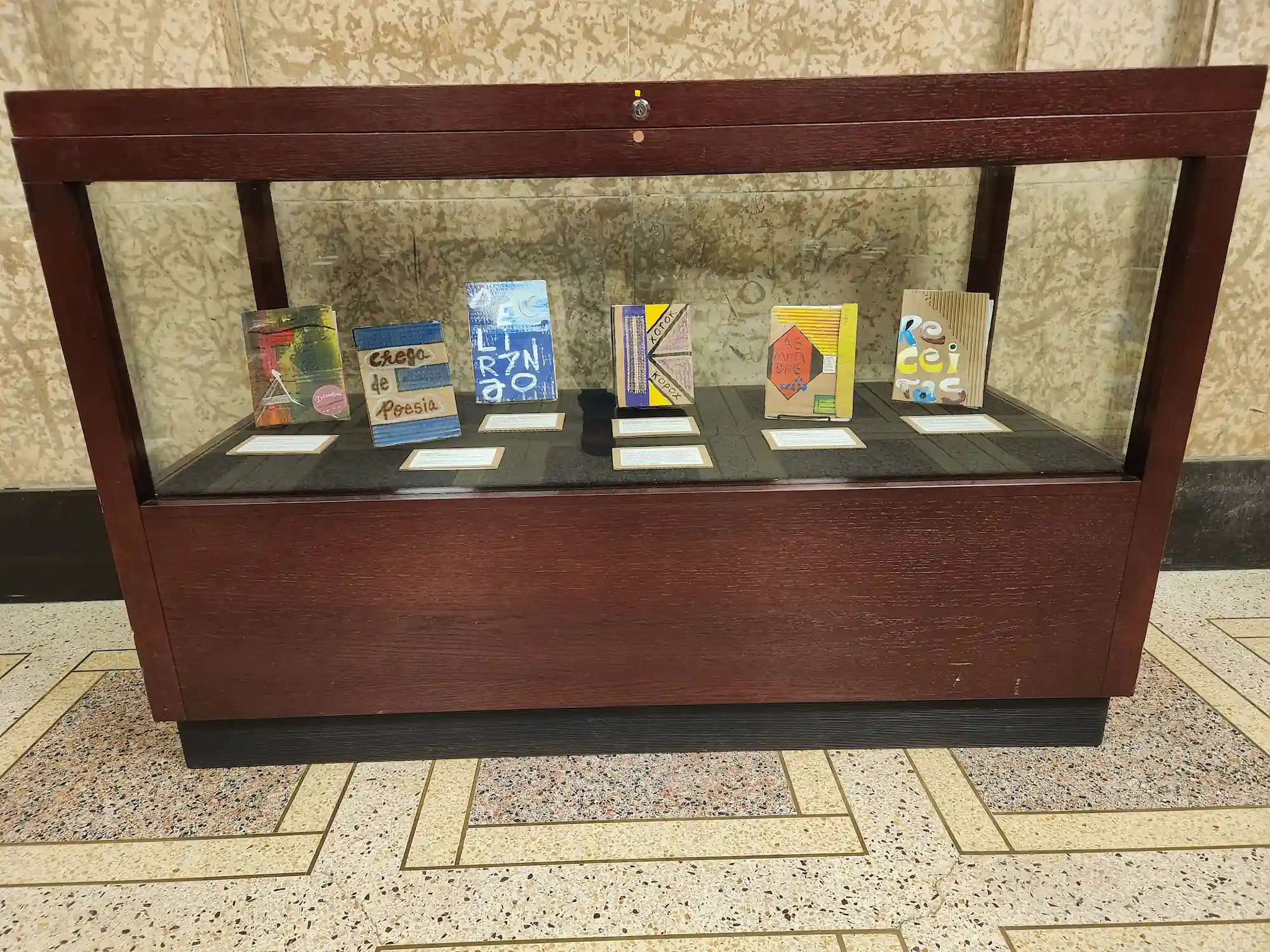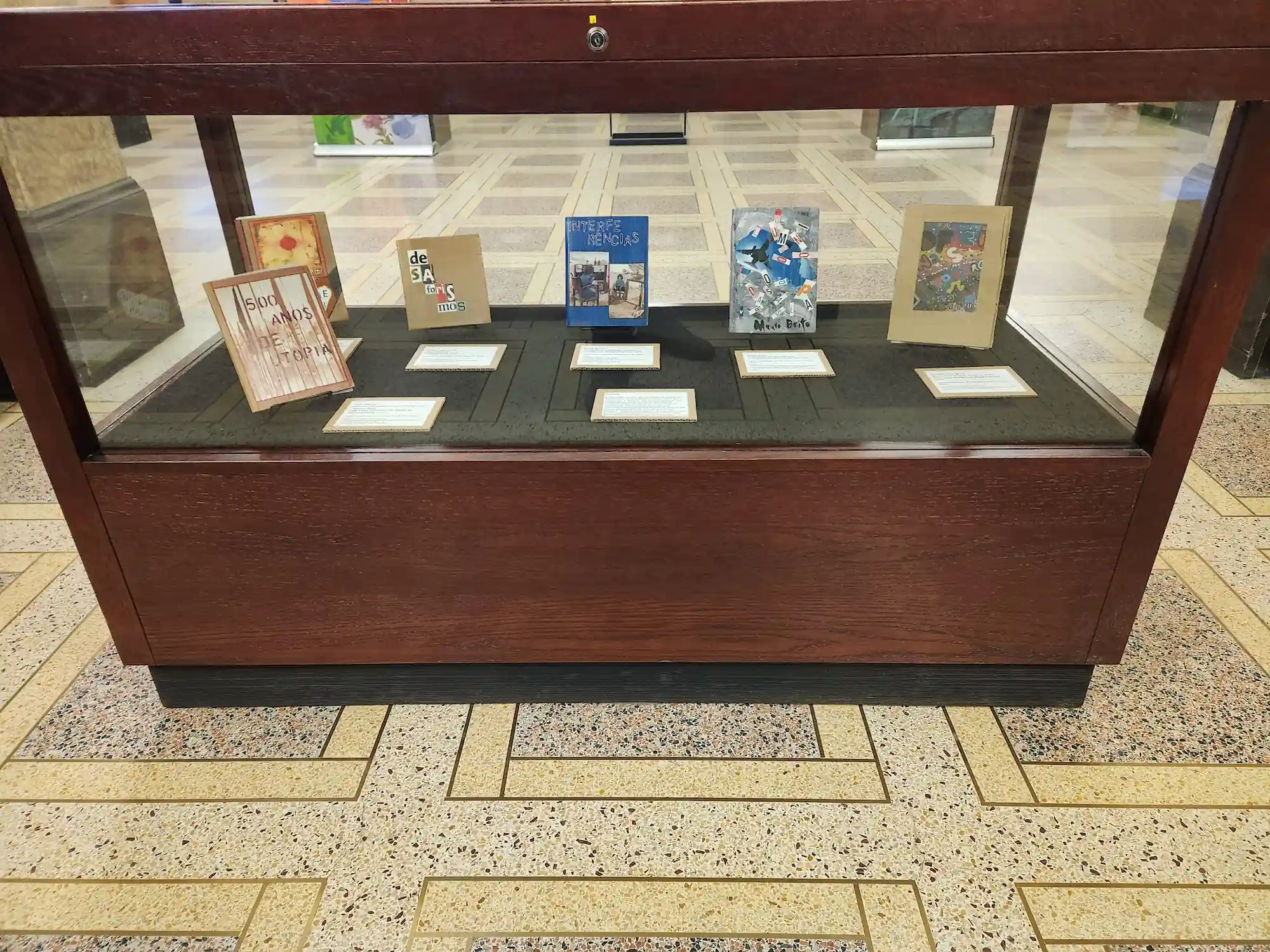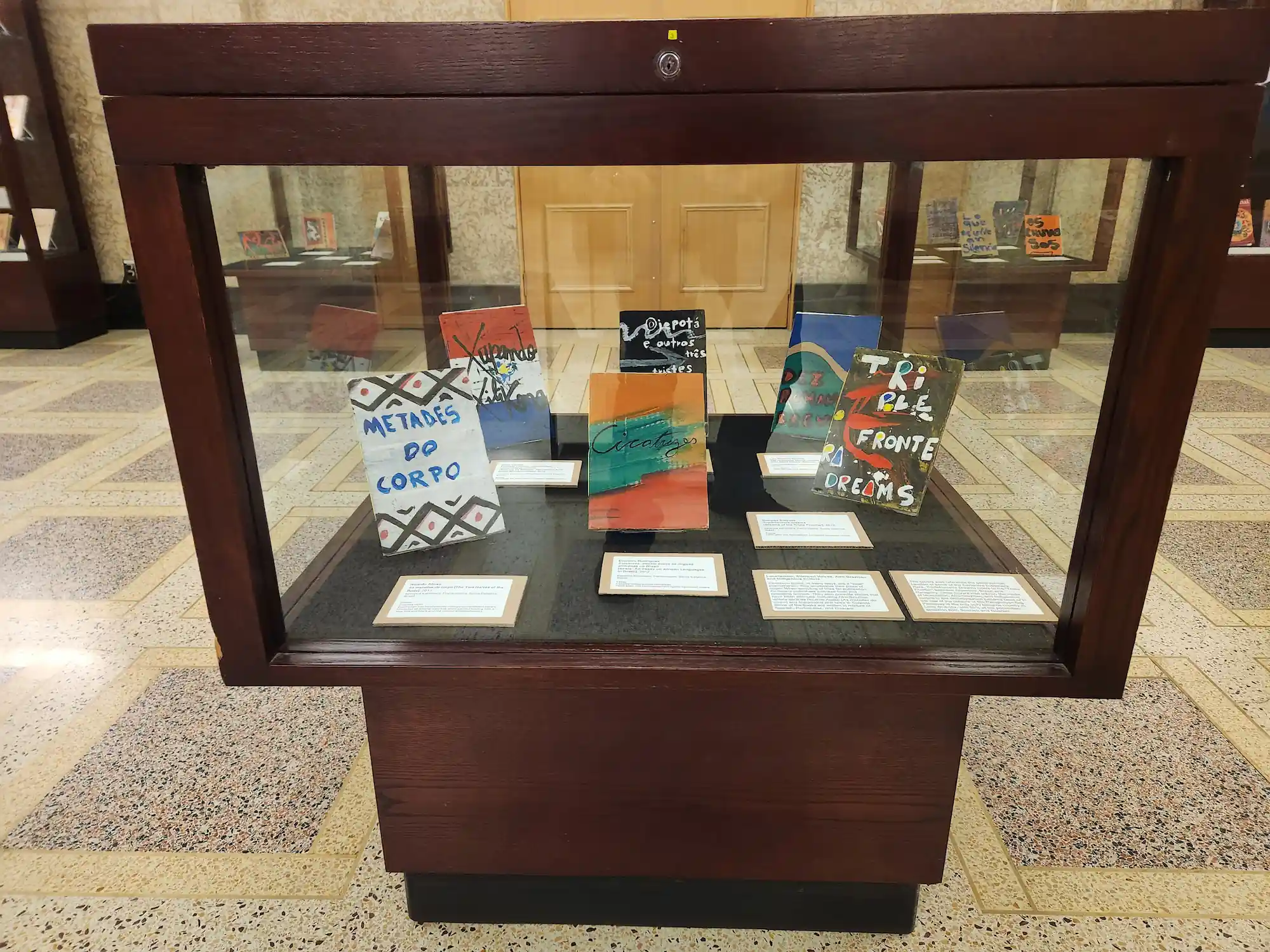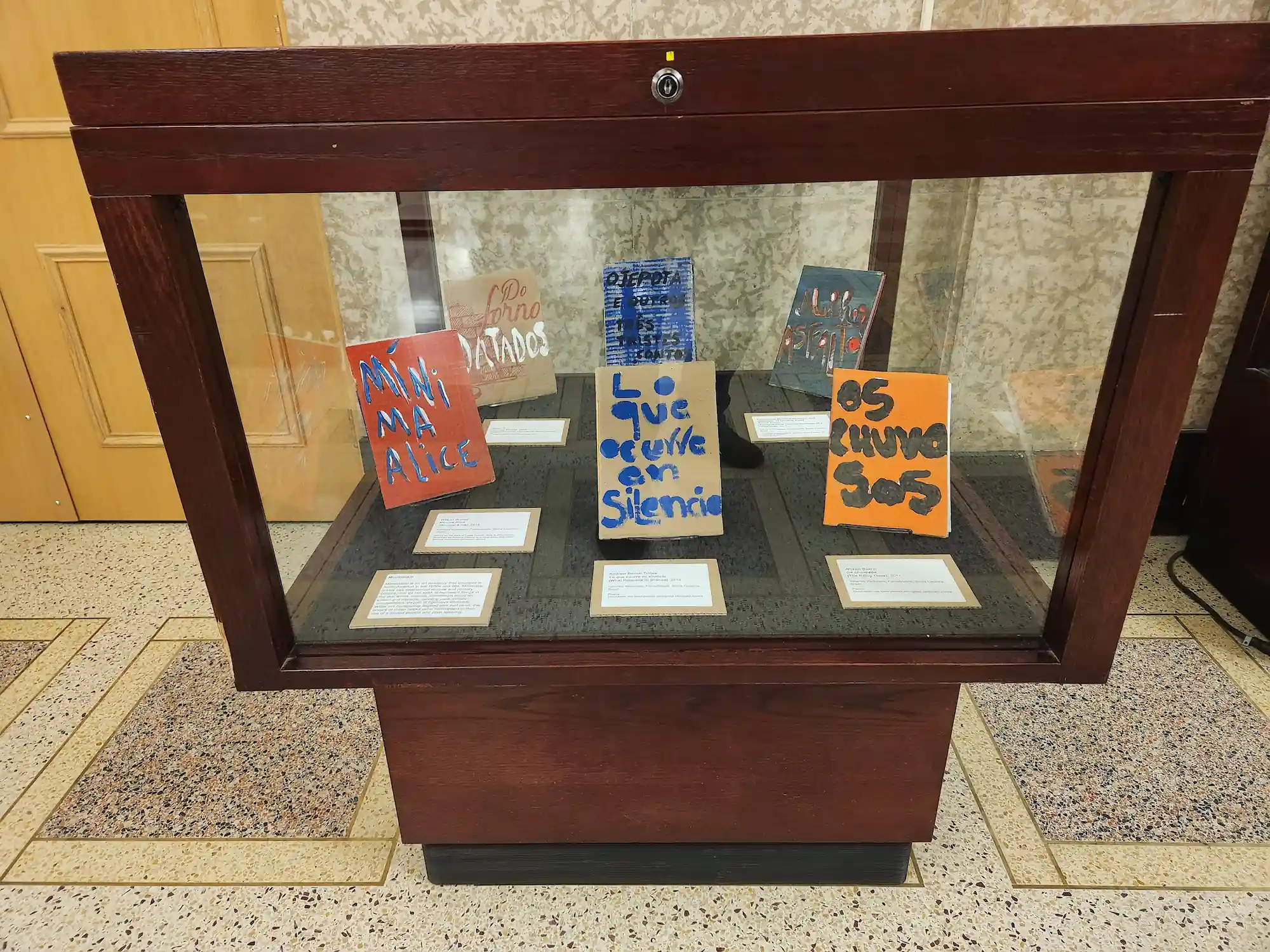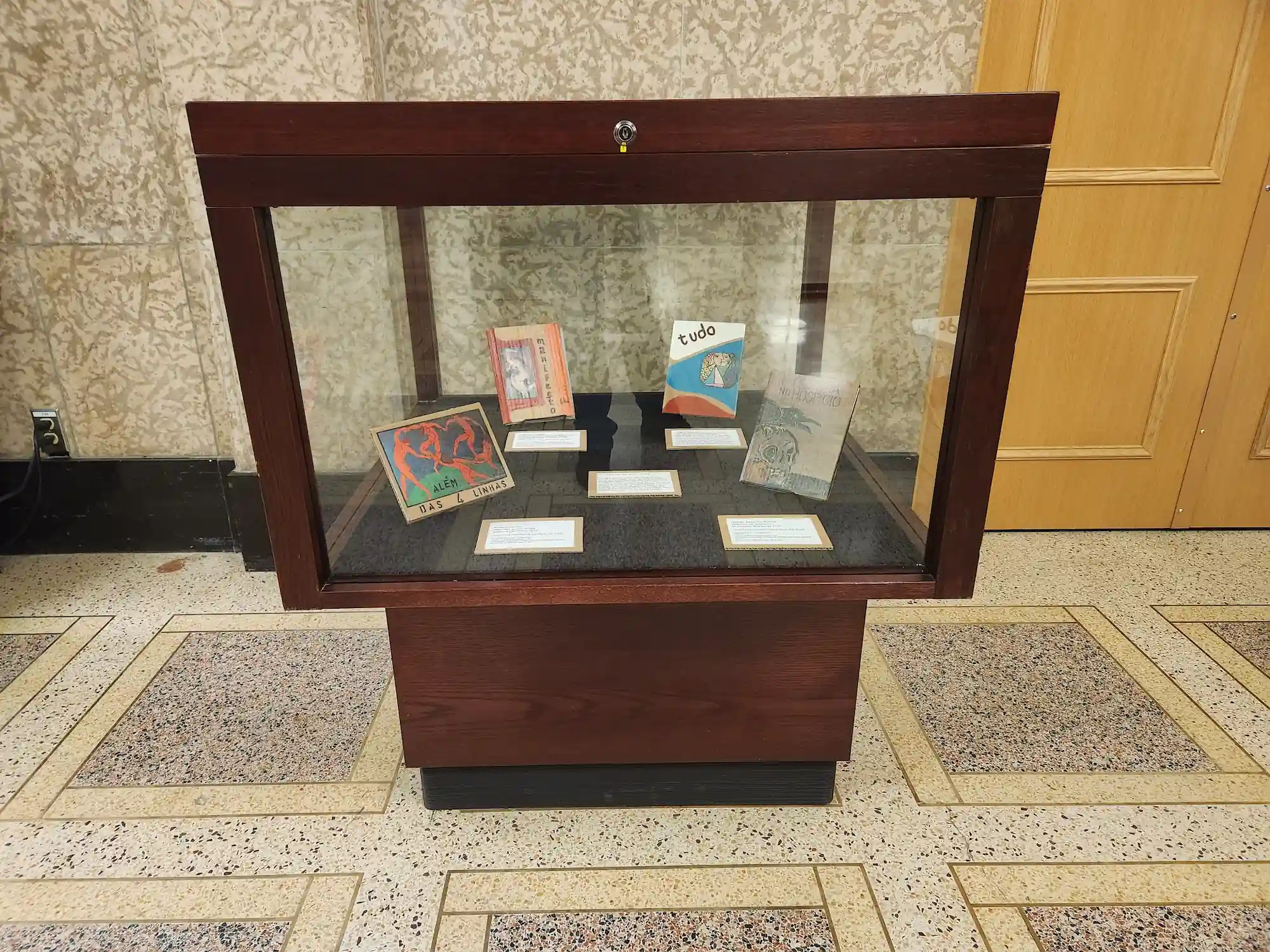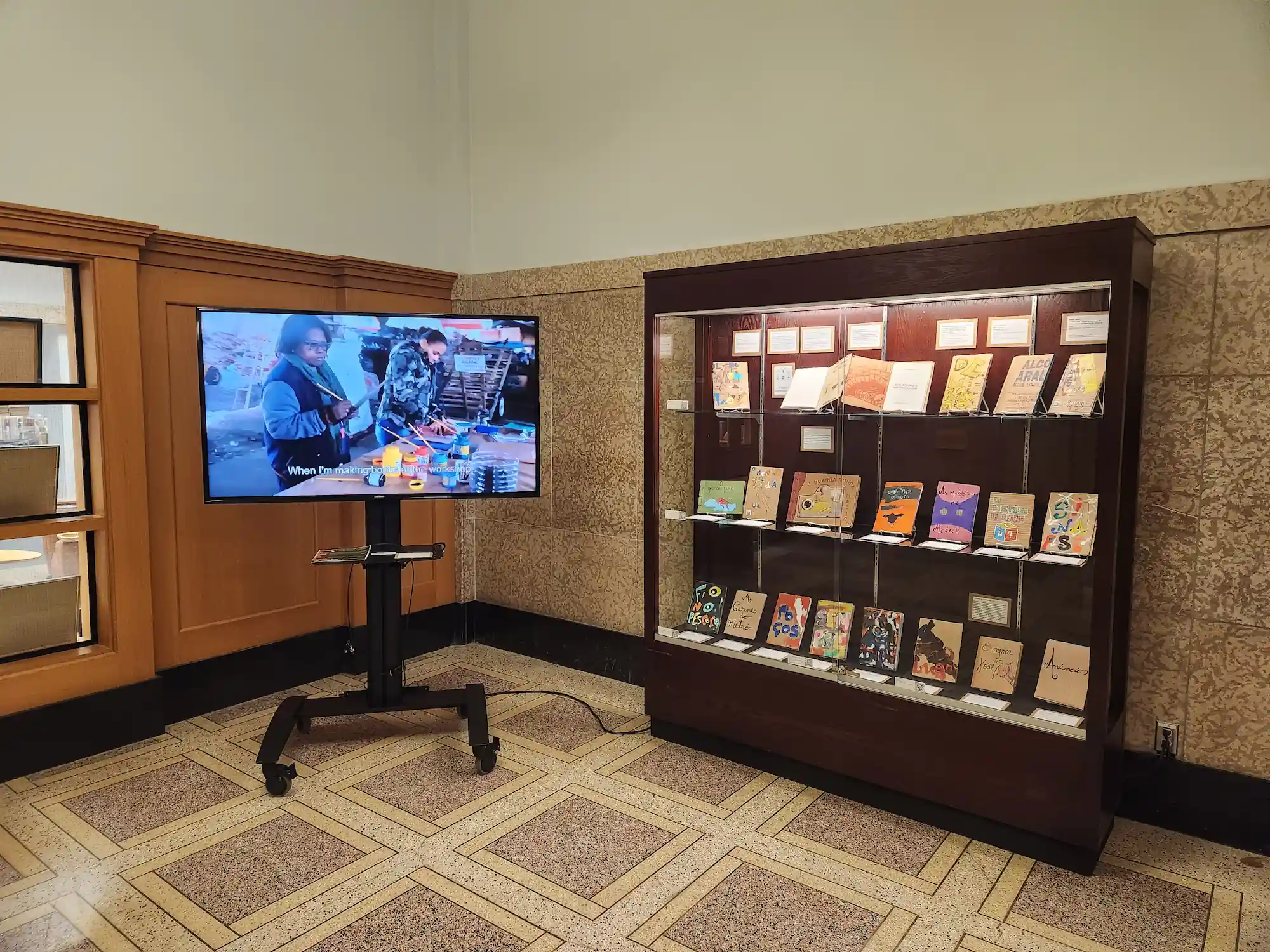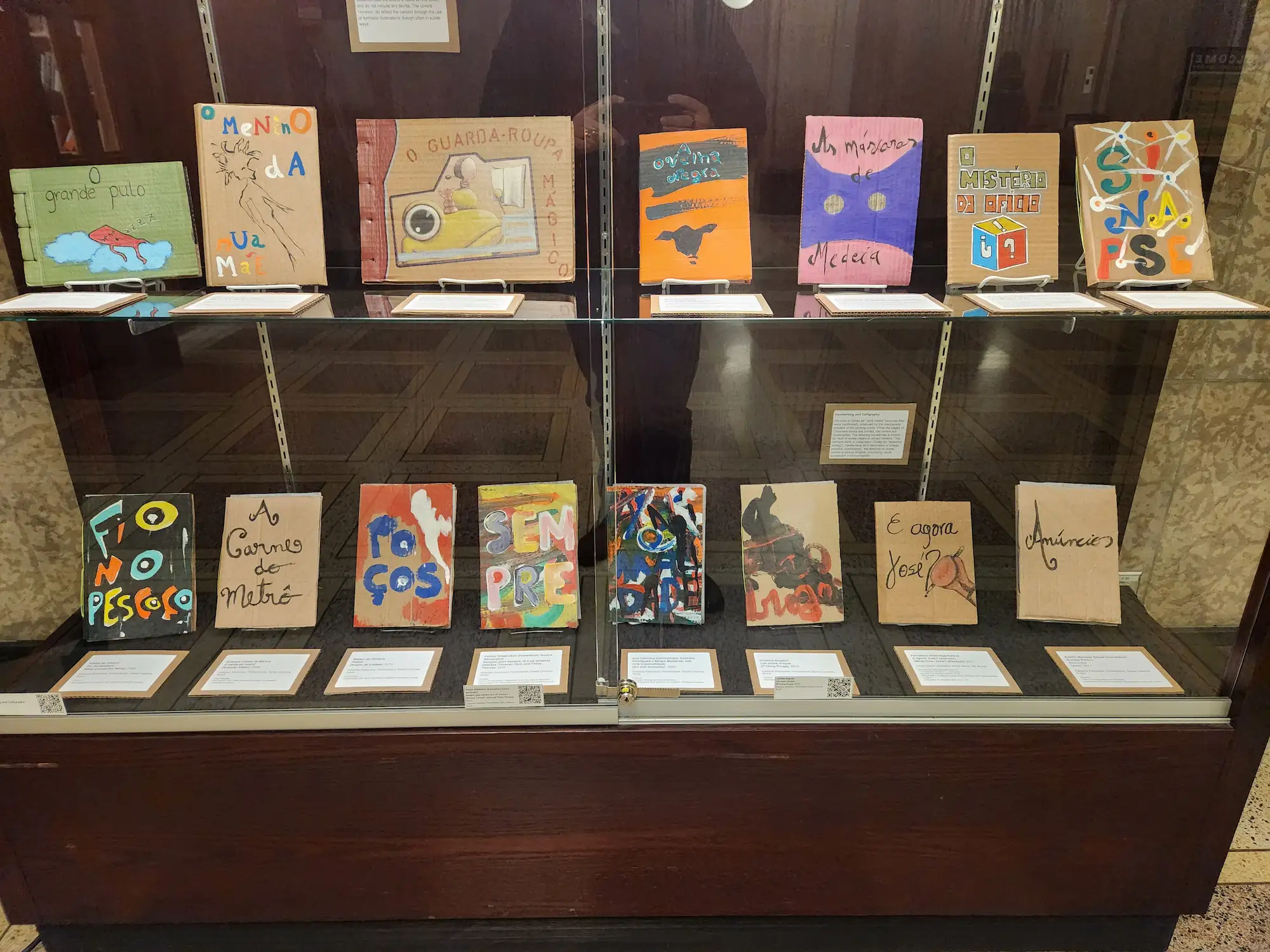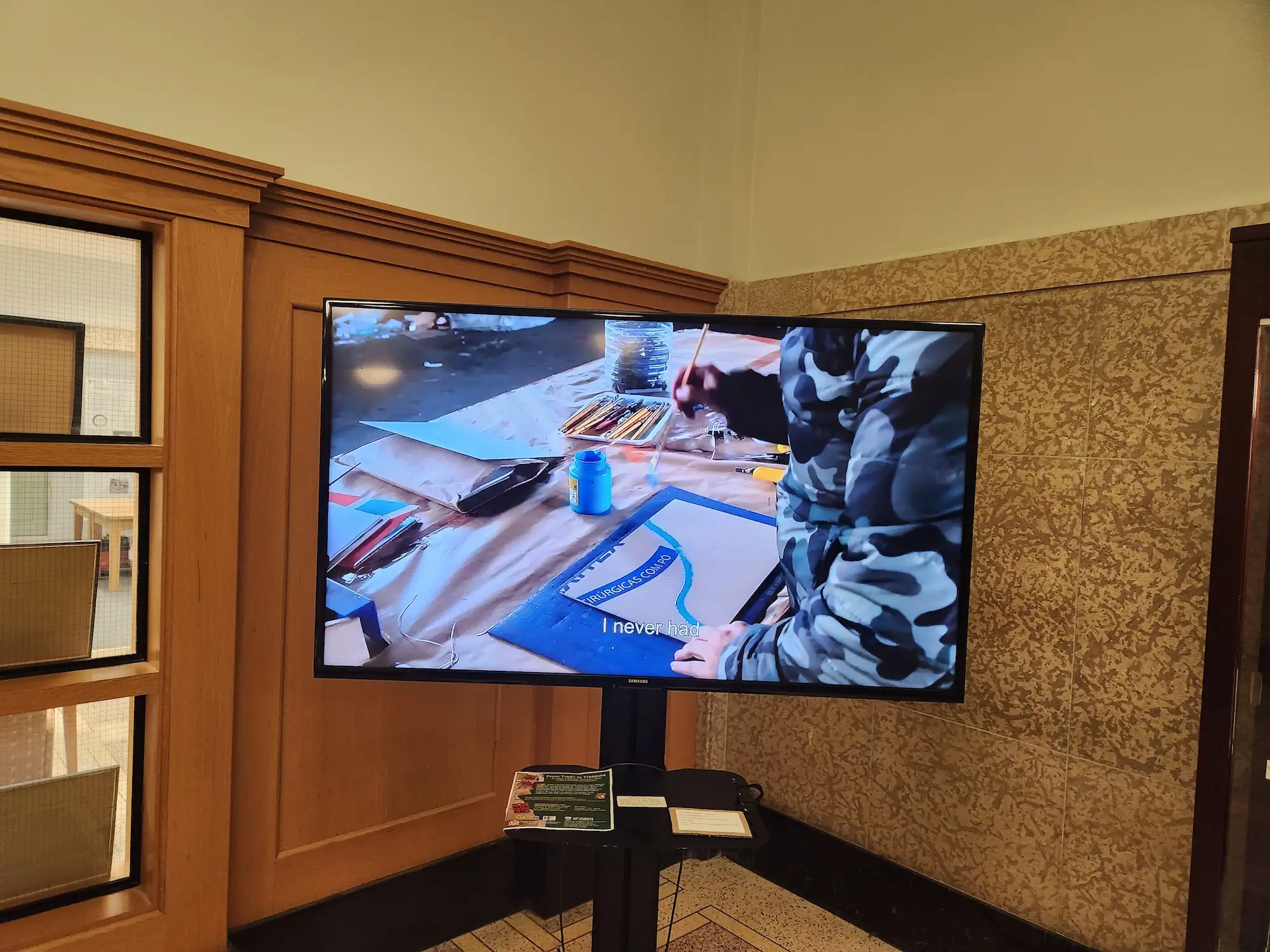Categorias dos Livros
Alberta Kartonera
O Website Alberta Kartonera foi lançado junto com a Exposição Do Lixo ao Tesouro, organizada pelo Department of Modern Languages and Cultural Studies (MLCS) [Departamento de Línguas Modernas e Estudos Culturais] e realizada em outubro de 2023 na Biblioteca Rutherford, na University of Alberta (UofA). O site ajudou a divulgar a exposição, que apresentou a coleção de livros Cartoneros brasileiros que fazem parte da Bruce Peel Special Collections (BPSC), que abriga mais de 100.000 livros raros e materiais de arquivo significativos que exploram uma variedade de tópicos locais e internacionais (Website BPSC, n.d.).
Além de promover a exposição, a Alberta Kartonera tem como objetivo se tornar uma editora Cartonera, inspirada por editoras latino-americanas como Katarina Kartonera (Brasil), Eloísa Cartonera (Argentina), entre outras.
A iniciativa envolve estudantes dos cursos do MLCS na UofA na produção de livros Cartoneros e na oferta de oficinas em escolas e bibliotecas. Até o momento, nenhum livro foi publicado pela Alberta Kartonera.
Colagem
De “coller”, francês para "colar", uma colagem é uma composição que utiliza pedaços de papel, tecido, etc., colados em uma superfície. Os materiais colados fazem referência a algo no mundo, mas também atuam como elementos da composição. Quando justapostos, os elementos geram novos significados.
A colagem moderna tem suas raízes nos artistas cubistas Georges Braque e Pablo Picasso.
Esses livros apresentam técnicas de colagem ao utilizarem imagens e letras recortadas de materiais impressos e coladas nas capas.
Esquemas de Cores
Os livros Cartoneros são frequentemente caracterizados por capas vibrantes. Vários dos livros Cartoneros na BPSC possuem capas com padrões visuais semelhantes, às vezes utilizando cores complementares.
Isso pode sugerir que foram criados por volta da mesma época, embora isso não seja necessariamente o caso.
Esses livros utilizam esquemas de cores semelhantes, mas têm datas de publicação diferentes.
Manuscrito e Caligrafia
Nos referimos aos livros como "mídia impressa" porque eram tradicionalmente produzidos pelo processo mecânico da prensa tipográfica. Embora as páginas dos livros Cartoneros sejam impressas, as capas são feitas artesanalmente. As letras, às vezes, são escritas à mão em estilos projetados para atrair leitores.
Isso remete à "caligrafia" (do grego para "escrita bonita"), a prática de escrever à mão de forma decorativa ou artística.
Curiosamente, a tipografia em algumas capas é quase ilegível, priorizando a expressão visual em detrimento da legibilidade.
Ilustração
Curiosamente, muitas capas de livros na coleção Cartonera não apresentam o nome do autor e não incluem resumos.
As capas, no entanto, refletem o conteúdo por meio de ilustrações simbólicas, embora frequentemente de maneira sutil.
Katarina Kartonera
Os livros da Katarina Kartonera são essencialmente feitos à mão, com capas únicas e exclusivas que nunca se repetem.
Eles nasceram de uma consciência social de inclusão, reciclando materiais como papelão e envolvendo a participação de catadores, escritores, educadores, estudantes, pesquisadores e artistas, tanto na produção quanto na distribuição.
Eles promovem literatura contemporânea NÃO COMERCIAL por meio de iniciativas sociais, fortalecendo a cultura e a educação sem nenhum financiamento ou patrocínio externo. (Katarina Kartonera, n.d.)
localização e Vozes Culturais
Localização, Vozes Silenciadas,
Cultura Afro-Brasileira e Indígena
Os livros Cartoneros são um fenômeno marcadamente local que enfatizam suas origens, com editoras priorizando autores locais e emergentes enquanto promovem vozes silenciadas, incluindo escritores afro-brasileiros como Ricardo Aleixo (As metades do corpo) e contos orais indígenas em Ojepotá, às vezes mesclando espanhol, português e guarani.
As capas também refletem a localização geográfica e cultural, como visto em Triplefronteira Dreams [Sonhos da Tríplice Fronteira], que faz referência à “Tríplice Fronteira” entre Argentina, Brasil e Paraguai, e outras capas que incorporam elementos afro-brasileiros e indígenas ou as cores da bandeira paraguaia, destacando o status único do Paraguai como o único país verdadeiramente bilíngue da América Latina, onde 90% da população fala tanto espanhol quanto guarani.
Minimalismo
O minimalismo é uma tendência artística que surgiu na América do Norte nas décadas de 1950 e 60. Caracterizado pela criação de obras de arte baseadas em formas geométricas e cores puras, ele contrariou o impulso mimético de representar coisas do mundo real.
Em vez disso, os artistas minimalistas estavam interessados na pintura como cor e material, tornando suas composições puras, simples e independentes de qualquer representação figurativa.
As capas desses livros ecoam essa tendência ao utilizar uma paleta limitada e letras simples, evitando ornamentação excessiva.
Estêncil
O estêncil é uma técnica nas artes visuais usada para reproduzir letras, imagens ou designs, aplicando tinta a um molde, uma peça de papelão ou metal com formas recortadas. A tinta que passa pelos recortes para o papel ou superfície cria as letras ou formas desejadas. Estênceis podem reproduzir um padrão de maneira rápida e fácil, por isso são frequentemente usados para placas de rua e grafite.
A tipografia nas capas desses livros literalmente usa estêncil ou sugere essa técnica. Por ser uniforme, a tipografia contrasta com as capas que exibem títulos escritos em uma caligrafia mais expressiva e cursiva, além de evocar o ambiente urbano.
Textura
Além da colagem, que combina uma variedade de materiais, outras técnicas destacam o aspecto de textura dos livros Cartoneros. Como são feitos de papelão ondulado reciclado, em muitas das capas desses livros é possível ver as dobras ou sulcos da folha ondulada entre as duas camadas lisas de revestimento.
Certas capas foram tratadas com um brilho especial que torna os sulcos mais aparentes. Em outros casos, o revestimento de um lado foi parcialmente rasgado para revelar a folha ondulada. Outras capas incluem tecidos colados, criando padrões não apenas visuais, mas também táteis.
A Aura do Livro & Capas Únicas
Em seu ensaio [“A Obra de Arte na Era da Reprodutibilidade Mecânica”] (1935), o crítico alemão Walter Benjamin cunhou o conceito de "aura" de uma obra de arte.
Benjamin via a obra de arte como um objeto único, existente no tempo e no espaço. Na época, porém, a fotografia estava ganhando terreno e desfocando a distinção entre cópia e original, ameaçando o status privilegiado da arte. Por que ir ver a Mona Lisa no Louvre, se você pode carregar um cartão postal dela no seu bolso?
Benjamin reconheceu o potencial democratizante da fotografia, já que ela tornava a arte acessível a pessoas que não podiam arcar com os custos de viajar para ver o original em um museu. Ao mesmo tempo, o processo de reprodução mecânica implicava a perda da “aura”, a qualidade especial que se dizia ser exclusiva do objeto de arte.
Como os livros Cartoneros têm capas únicas para a mesma obra, de certa forma, eles tentam restaurar a “aura” aos livros, objetos que, invariavelmente, são mecanicamente reproduzidos.
Podemos ver uma variedade de capas correspondentes ao mesmo título.
Traços de Reciclagem
As capas desses livros são feitas de papelão ondulado adquirido de cartoneros (espanhol) ou catadores (português), recicladores urbanos na América Latina. A reutilização desse material torna esses livros um testemunho das práticas sustentáveis que surgiram nessa região, muitas vezes devido à necessidade econômica.
Em muitas dessas capas, ainda podemos ler o que foi impresso no papelão, o que nos dá uma pista sobre para que as caixas foram usadas.
Isso adiciona uma camada de história aos livros e também gera novos significados: por exemplo, símbolos indicando que as caixas devem ser protegidas da chuva ou que o conteúdo é frágil são integrados à capa, sugerindo aos leitores que os livros também devem ser "manuseados com cuidado."
Vento Norte Cartonero
O projeto Vento Norte Cartonero foi criado em 2013 pela Maria Papelão Editora, em Santa Maria-RS, Brasil, como um espaço alternativo e independente para a publicação de livros com capas artesanais, apresentando tanto autores já publicados quanto inéditos.
Segue a mesma linha de outras cartoneras na América Latina, tendo a Eloísa Cartonera—a primeira do gênero, criada em 2003 em Buenos Aires—como inspiração.
Ao longo dos anos, vários livros de diversos autores e gêneros foram publicados, enquanto inúmeras oficinas foram realizadas em escolas públicas com o objetivo de demonstrar o processo de criação de livros e desmistificá-lo como um objeto sagrado e distante. (Matinal Jornalismo, n.d.)
Citação Visual & Intertextualidade
Assim como um autor literário pode citar outro autor em um texto, uma técnica conhecida como “intertextualidade,” artistas e designers podem referenciar ou incluir diretamente uma imagem de outro artista em suas criações.
Algumas dessas capas de livros reproduzem imagens de pinturas de Pablo Picasso, Henri Matisse e Michelangelo.
As imagens são utilizadas tanto como elementos da composição quanto como ilustrações criativas do conteúdo do livro.
Do Lixo ao Tesouro nas Notícias
UFSC leva exposição "Do Lixo ao Tesouro" a universidade no Canadá
Notícias da UFSC | Artigo de Notícia
A professora do Departamento de Artes da Universidade Federal de Santa Catarina (UFSC), Dirce Waltrick do Amarante, e o estudante e editor da Katarina Kartonera, Evandro Rodrigues, estão participando esta semana do lançamento da exposição “Do Lixo ao Tesouro” na University of Alberta, no Canadá.
A exposição será inaugurada na quinta-feira, 5 de outubro, quando Dirce e Evandro participarão virtualmente do evento para falar sobre o projeto. (Notícias da UFSC, 2023)
[Do Lixo ao Tesouro: Uma Exposição
de Livros "Cartoneros" Brasileiros]
Edmonton Journal | The List |
Guia de Entretenimento
"Em 2001, quando uma grave crise financeira atingiu a América Latina, catadores de papelão conhecidos como 'cartoneros' foram às ruas para sobreviver. Em solidariedade, artistas e escritores compraram o papelão e criaram livros acessíveis e sustentáveis com capas artesanais únicas."
“Com um foco especial nos distintos títulos brasileiros que fazem parte da coleção, nosso objetivo é educar os visitantes sobre a rica tapeçaria do 'Cartonerismo' e a resiliência dos 'cartoneros'.” (Alberta Kartonera, 2023)
[Livros Feitos de Material Reciclado]
CBC Listen | Radio Active | Entrevista de Rádio
Odile Cisneros – PhD, Professora Pesquisadora na Universidade de Alberta, no Departamento de Línguas Modernas e Estudos Culturais, e responsável pela organização da exposição Do Lixo ao Tesouro, é entrevistada por Jessica Ng e Min Dhariwal.
"Vamos ouvir sobre uma nova exposição na Universidade de Alberta que celebra um novo tipo de livro feito à mão com papelão reciclado." (CBC Listen, 2023).
UFSC leva exposição “Do Lixo ao Tesouro” para universidade do Canadá
Rádio Ponto | O Som da Notícia | Entrevista de Rádio
A Dra. Odile Cisneros é entrevistada no programa de rádio O Som da Notícia.
"O Som da Notícia é produzido pela turma B da disciplina de Áudio e Radiojornalismo do 1º semestre do curso de Jornalismo da Universidade Federal de Santa Catarina", e é transmitido pela estação de rádio Rádio Ponto (Rádio Ponto, 2023).
["Do Lixo ao Tesouro" expõe um
fenômeno notável desencadeado
pela reciclagem de papelão]
The Gateway | Artigo de Notícia
Uma exposição atual da Bruce Peel Special Collections da University of Alberta mostra como a empatia e a criatividade combinadas permitiram uma solução ainda mais acessível na América Latina.
“Do Lixo ao Tesouro” exibe mais de 50 livros cartoneros brasileiros, com capas feitas de papelão reciclado. (The Gateway, 2023)
UFSC leva exposição "Do Lixo ao Tesouro" a universidade no Canadá
Notícias da UFSC | Artigo de Notícia
A professora do Departamento de Artes da Universidade Federal de Santa Catarina (UFSC), Dirce Waltrick do Amarante, e o estudante e editor da Katarina Kartonera, Evandro Rodrigues, estão participando esta semana do lançamento da exposição “Do Lixo ao Tesouro” na University of Alberta, no Canadá.
A exposição será inaugurada na quinta-feira, 5 de outubro, quando Dirce e Evandro participarão virtualmente do evento para falar sobre o projeto. (Notícias da UFSC, 2023)
[Do Lixo ao Tesouro: Uma Exposição
de Livros "Cartoneros" Brasileiros]
Edmonton Journal | The List |
Guia de Entretenimento
"Em 2001, quando uma grave crise financeira atingiu a América Latina, catadores de papelão conhecidos como 'cartoneros' foram às ruas para sobreviver. Em solidariedade, artistas e escritores compraram o papelão e criaram livros acessíveis e sustentáveis com capas artesanais únicas."
“Com um foco especial nos distintos títulos brasileiros que fazem parte da coleção, nosso objetivo é educar os visitantes sobre a rica tapeçaria do 'Cartonerismo' e a resiliência dos 'cartoneros'.” (Alberta Kartonera, 2023)
[Livros Feitos de
Material Reciclado]
CBC Listen | Radio Active | Entrevista de Rádio
Odile Cisneros – PhD, Professora Pesquisadora na Universidade de Alberta, no Departamento de Línguas Modernas e Estudos Culturais, e responsável pela organização da exposição Do Lixo ao Tesouro, é entrevistada por Jessica Ng e Min Dhariwal.
"Vamos ouvir sobre uma nova exposição na Universidade de Alberta que celebra um novo tipo de livro feito à mão com papelão reciclado." (CBC Listen, 2023).
UFSC leva exposição “Do Lixo ao Tesouro” para universidade do Canadá
Rádio Ponto | O Som da Notícia |
Entrevista de Rádio
A Dra. Odile Cisneros é entrevistada no programa de rádio O Som da Notícia.
"O Som da Notícia é produzido pela turma B da disciplina de Áudio e Radiojornalismo do 1º semestre do curso de Jornalismo da Universidade Federal de Santa Catarina", e é transmitido pela estação de rádio Rádio Ponto (Rádio Ponto, 2023).
["Do Lixo ao Tesouro" expõe um
fenômeno notável desencadeado
pela reciclagem de papelão]
The Gateway | Artigo de Notícia
Uma exposição atual da Bruce Peel Special Collections da University of Alberta mostra como a empatia e a criatividade combinadas permitiram uma solução ainda mais acessível na América Latina.
“Do Lixo ao Tesouro” exibe mais de 50 livros cartoneros brasileiros, com capas feitas de papelão reciclado. (The Gateway, 2023)
UFSC leva exposição "Do Lixo ao Tesouro" a universidade no Canadá
Notícias da UFSC | Artigo de Notícia
A professora do Departamento de Artes da Universidade Federal de Santa Catarina (UFSC), Dirce Waltrick do Amarante, e o estudante e editor da Katarina Kartonera, Evandro Rodrigues, estão participando esta semana do lançamento da exposição “Do Lixo ao Tesouro” na University of Alberta, no Canadá.
A exposição será inaugurada na quinta-feira, 5 de outubro, quando Dirce e Evandro participarão virtualmente do evento para falar sobre o projeto. (Notícias da UFSC, 2023)
[Do Lixo ao Tesouro: Uma Exposição
de Livros "Cartoneros" Brasileiros]
Edmonton Journal | The List | Guia de Entretenimento
"Em 2001, quando uma grave crise financeira atingiu a América Latina, catadores de papelão conhecidos como 'cartoneros' foram às ruas para sobreviver. Em solidariedade, artistas e escritores compraram o papelão e criaram livros acessíveis e sustentáveis com capas artesanais únicas."
“Com um foco especial nos distintos títulos brasileiros que fazem parte da coleção, nosso objetivo é educar os visitantes sobre a rica tapeçaria do 'Cartonerismo' e a resiliência dos 'cartoneros'.” (Alberta Kartonera, 2023)
[Livros Feitos de
Material Reciclado]
CBC Listen | Radio Active | Entrevista de Rádio
Odile Cisneros – PhD, Professora Pesquisadora na Universidade de Alberta, no Departamento de Línguas Modernas e Estudos Culturais, e responsável pela organização da exposição Do Lixo ao Tesouro, é entrevistada por Jessica Ng e Min Dhariwal.
"Vamos ouvir sobre uma nova exposição na Universidade de Alberta que celebra um novo tipo de livro feito à mão com papelão reciclado." (CBC Listen, 2023).
UFSC leva exposição “Do Lixo ao Tesouro” para universidade do Canadá
Rádio Ponto | O Som da Notícia |
Entrevista de Rádio
A Dra. Odile Cisneros é entrevistada no programa de rádio O Som da Notícia.
"O Som da Notícia é produzido pela turma B da disciplina de Áudio e Radiojornalismo do 1º semestre do curso de Jornalismo da Universidade Federal de Santa Catarina", e é transmitido pela estação de rádio Rádio Ponto (Rádio Ponto, 2023).
["Do Lixo ao Tesouro" expõe um
fenômeno notável desencadeado
pela reciclagem de papelão]
The Gateway | Artigo de Notícia
Uma exposição atual da Bruce Peel Special Collections da University of Alberta mostra como a empatia e a criatividade combinadas permitiram uma solução ainda mais acessível na América Latina.
“Do Lixo ao Tesouro” exibe mais de 50 livros cartoneros brasileiros, com capas feitas de papelão reciclado. (The Gateway, 2023)
Click on the Titles to read or listen to the complete news.
